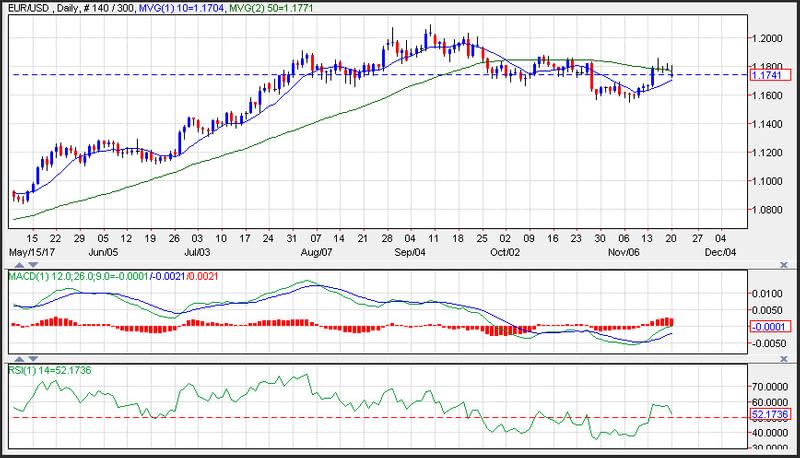EUR/USD Daily Technical Analysis for November 21, 2017
The EUR/USD edged lower and continues to form a mini-bull flag pattern, but fundamental and political events conspired against the currency pair on Monday as a softer than expected German PPI and the failure of Merkel to form a coalition weighed on the EUR/USD currency pair.
Technicals
The EUR/USD is trading sideways and hovering near the 1.1800 level, after pushing lower early in the trading session to test support near the 10-day moving average at 1.1704. Short term resistance is seen near the 50-day moving average at 1.1771. Positive momentum is decelerating as the MACD (moving average convergence divergence) histogram is printing in the black, but the trajectory of the MACD histogram is negative which points to consolidation in the currency pair. The RSI is also trading sideways printing a reading of 52, which is in the middle of the neutral range and reflects consolidation.

German PPI Fell Back
German PPI producer price inflation fell back to 2.7% year over year in October, from 3.1% year over year in the previous month. Pretty much as expected and with the deceleration to a large extent due to lower energy prices, which rose 2.8% year over year in October, after jumping 4.9% year over year in September. Heating oil price increases moderated and dropped back to 5.7% year over year, after spiking to a whopping 18.9% year over year in the previous month. Food price inflation also decelerated, but remains at relatively high levels. While the headline rate came down, the numbers also confirm that underlying inflation pressures are slowly picking up, with energy and food prices not the only contributors to a headline rate that is clearly above the ECB’s 2% mark. Indeed, PPI excluding energy accelerated to 2.7% year over year from 2.6% year over year in the previous month.
U.S. Junk Sees Exodus
An exodus from U.S. high yield debt this past week including mutual funds and ETFs totaled some $4.43 billion according to Bank of America, the third largest drop on record and the biggest decline since August of 2014. The tax status of junk bonds in the pending tax reform legislation remains an open question, while short-dated market yields have continued to rise to trend highs as the Fed slowly removes the punch bowl, in addition to valuation concerns. This has led to some divergence in junk bond returns in November that only recently appeared to be noticed by stock investors.
German Coalition Talks Fail
German coalition talks fail, putting Merkel on the spot. German Chancellor Merkel is facing the risk of new elections after preliminary coalition talks with the liberal FDP and the Green Party failed over the weekend. Former coalition partner SPD has already ruled out a renewed coalition with Merkel’s CDU/CSU and neither the far left nor the far right are possible partners for Merkel, leaving her with little choice but new elections, if neither SPD nor FDP change their minds after forcing the Chancellor to make more concessions. The EUR already dropped sharply and other markets are also likely to feel the fallout from heightened political risks in the Eurozone’s largest economy.
U.S. QSS Figures Show Gains
The U.S. QSS figures that track activity for the service sector revealed a 5.3% Q3 year over year gain in the aggregate “selected services” measure that undershot the 5.9% rise in Q2. For the larger components, we saw a 6.4% year over year rise in the finance and insurance component, and a 4.4% year over year rise for the healthcare and social assistance component. The components used to calculate the GDP growth figure suggest to us a $2 billion boost in service consumption but no revision for intellectual property investment, and we still expect a Q3 GDP growth boost to 3.5% from 3.0%.
The U.S. Senate deficit hawks are reportedly balking at the ultimate cost of temporary tax cuts likely becoming permanent. Coincidently, a couple of the heel-draggers on the deficit implications are Trump-foes Bob Corker of Tennessee and Jeff Flake of Arizona, adding a political dimension to the debate. The Senate has $1.5 trillion to play with before it needs more than a simple majority to pass the bill and thereby likely requiring Democratic support. Though Wisconsin’s Ron Johnson had issues with the treatment of small businesses, he has since suggested that these could be addressed. Some 35 provisions are supposed to sunset before 10-years are up, but frequently are subsequently re-upped and ultimately add to the deficit, contravening the budget rules.
This article was originally posted on FX Empire
More From FXEMPIRE:
German Turmoil and US Tax Reform Weigh on Markets, Bitcoin Breaks $8100
E-mini NASDAQ-100 Index (NQ) Futures Technical Analysis – November 20, 2017 Forecast
EUR/USD Mid-Session Technical Analysis for November 20, 2017
Comex High Grade Copper Price Futures (HG) Technical Analysis – November 20, 2017 Forecast
K-DNA Financial Services Ltd. Launch New Regulated Trading Site

 Yahoo Finance
Yahoo Finance 